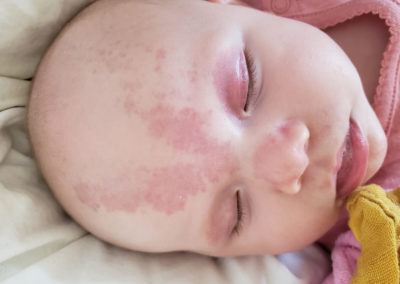Port-Wine Stain
Medically reviewed by The Dermatologists and written by Dr. Alexander Börve
Rare
Occurring on 0.3% of newborns
- Requires medical diagnosis
- Symptoms: Skin thickening, red spots
- Color: Typically pink, and then dark red or puplish
- Location: Generally on the face, arms or legs
- Treatment: Lubrication, laser surgery, chemical peels, phototherapy
ICD-9: 757.32
A port-wine stain is a birthmark caused by a kind of malformation of the skin’s small blood vessels. It is a rare condition, occurring on 0.3% of newborns.
The malformation of blood vessels creates a dark red spot on the skin, which looks like maroon wine was spilled or splashed on the skin.
Symptoms
Port-wine stains are usually pink and flat in the early stage. Over time, the color may deepen to a dark red or purplish color. The affected area may also thicken and take on a pebble-like appearance.
These stains usually appear on the face, arms or legs. Some stains are barely noticeable, especially when they are located somewhere other than the face.
Try our FREE dermatology search engine and get peace of mind within a second
What can I do?
People with port-wine stains may have emotional and social problems related to their appearance. If your child has very visible port-wine stains, make sure to keep track of his/her emotional health.
Port-wine stains on or near the eye or on the forehead need to be monitored. They may be associated with a sort of Sturge-Weber Syndrome, which causes problems like seizures, developmental delays, and learning disabilities. Stains on the eyelids may also lead to glaucoma. The increased pressure inside the eye that can affect vision and lead to blindness if left untreated.
Should I seek medical care?
In rare cases, port-wine stains are a sign of Sturge-Weber syndrome or Klippel-Trenaunay-Weber syndrome. Depending on the location of the birthmark and other symptoms, the provider may want to do an intraocular pressure test or x-ray of the skull. An MRI or CT scan of the brain may also be done.
Port-wine stains do not go away without treatment. If you are considering laser treatment, keep in mind that older stains may be more difficult to treat. Consult a healthcare provider for more information on the exact type of laser that should be used.
Treatment
This kind of mark will not disappear spontaneously, but it may fade slightly over time. It can be treated with a special laser.
The laser destroys the tiny blood vessels in the skin without significantly damaging the skin. Stains on the face respond better to laser therapy than those on the arms, legs, or middle of the body.
Other treatment methods include freezing, surgery, radiation and tattooing.
Try our FREE dermatology search engine and get peace of mind within a second
Source:
U.S. National Library of Medicine. Port-wine stain. Available at: https://www.nlm.nih.gov/medlineplus/ency/article/001475.htm
J. Stuart Nelson, M.D., Ph.D. Port Wine Stain. Vascular Birthmarks Foundation. Available at: https://birthmark.org/node/23
Ask a Dermatologist
Anonymous, fast and secure!

The Specialist doctor from the University Hospital in Gothenburg, alumnus UC Berkeley. My doctoral dissertation is about Digital Health and I have published 5 scientific articles in teledermatology and artificial intelligence and others.


